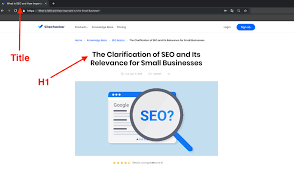Maximizing SEO Impact with Strategic Use of the H1 Tag
In the world of SEO (Search Engine Optimization), the
tag holds significant importance. The
tag, also known as the heading tag, is a crucial element in optimizing web pages for search engines. When used strategically, it can help improve a website’s visibility and ranking on search engine results pages.
The
tag is typically used to define the main heading or title of a webpage. Search engines like Google use these headings to understand the content and context of a page. By including relevant keywords in your
tag, you can signal to search engines what your page is about and improve its chances of ranking for those keywords.
It is important to remember that the
tag should accurately reflect the content of the page and be relevant to the overall topic. Using misleading or irrelevant headings can negatively impact your SEO efforts and confuse both search engines and visitors.
In addition to using keywords in your
tag, it is also essential to pay attention to other on-page SEO factors such as meta tags, image alt text, and internal linking. By creating a cohesive SEO strategy that includes optimizing your
tags along with other elements, you can increase your website’s visibility and attract more organic traffic.
In conclusion, the
tag plays a vital role in on-page SEO and should not be overlooked when optimizing your website for search engines. By using relevant keywords and creating informative headings, you can enhance your site’s visibility and improve its chances of ranking higher in search results.
Understanding H1 Tags: Key FAQs About Their Role and Impact in SEO
- What does H1 stand for?
- What does H1 means?
- What is the H1 of a website?
- What H1 means?
- What is H1 and H2 in SEO?
- How much does H1 affect SEO?
What does H1 stand for?
The term “H1” in SEO stands for Heading 1. In the context of web development and search engine optimization, the H1 tag is used to define the main heading or title of a webpage. It is an important HTML element that helps structure the content of a page and provides search engines with valuable information about the topic and relevance of the content. By strategically using keywords in the H1 tag, website owners can improve their chances of ranking higher in search engine results pages for specific queries related to their content. Understanding the significance of the H1 tag is essential for optimizing web pages for better visibility and organic traffic.
What does H1 means?
The term “H1” in the context of SEO refers to the
HTML tag, which is used to define the main heading or title of a webpage. In SEO, the
tag is a critical element that helps search engines understand the content and context of a page. By incorporating relevant keywords into the
tag, website owners can signal to search engines what their page is about and improve its chances of ranking for those specific keywords. It is essential for web developers and content creators to optimize their
tags effectively to enhance their website’s visibility and attract more organic traffic from search engines.
What is the H1 of a website?
The H1 of a website refers to the primary heading or title tag that is typically the largest and most prominent text on a webpage. It serves as a crucial element in SEO by signaling to search engines the main topic or theme of the page. The H1 tag plays a significant role in helping search engines understand the content and relevance of a webpage, making it essential for optimizing website visibility and ranking. By including relevant keywords in the H1 tag that accurately reflect the content of the page, website owners can improve their chances of ranking higher in search engine results pages and attracting organic traffic.
What H1 means?
The frequently asked question “What does H1 mean?” in the context of SEO refers to the
HTML tag used in web development. In SEO, the
tag is a crucial element that denotes the main heading or title of a webpage. It serves as a way to structure and organize content for both users and search engines. By using relevant keywords in the
tag, website owners can signal to search engines what their page is about and potentially improve its ranking in search results. Understanding the significance of the
tag is essential for optimizing web pages for better visibility and search engine performance.
What is H1 and H2 in SEO?
In the realm of SEO, understanding the significance of H1 and H2 tags is crucial for optimizing web pages effectively. The H1 tag, also known as the heading tag, is used to define the main heading or title of a webpage. It holds significant weight in signaling to search engines the primary topic and keywords of the page. On the other hand, H2 tags are used for subheadings within a page, providing structure and hierarchy to the content. By strategically incorporating relevant keywords in both H1 and H2 tags, website owners can improve their chances of ranking higher in search engine results pages and enhance overall visibility online. Mastering the use of H1 and H2 tags is a fundamental aspect of on-page SEO that can significantly impact a website’s performance in organic search results.
How much does H1 affect SEO?
The impact of the
tag on SEO is a commonly asked question among website owners and digital marketers. While the
tag is an important element in on-page SEO, its direct influence on search engine rankings may vary. Using relevant keywords in your
tag can help search engines understand the content and context of your page, potentially improving its visibility and ranking. However, it is essential to consider other SEO factors such as high-quality content, backlinks, site speed, and mobile-friendliness to achieve comprehensive optimization. While the
